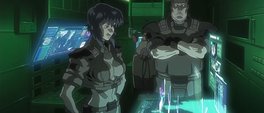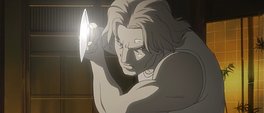Ghost in the Shell: Stand Alone Complex
The news of a Ghost in the Shell television series was met with a mix of joy and trepidation; highly regarded in the West and being helmed by a then unknown director, the assumption would be that the themes and delicately balanced characters of the Mamoru Oshii movie as well as the racy futurism of the original Masamune Shirow manga would be lost on a televised broadcast. Defying expectations however the series is supremely accomplished, blending the setting of a near-future, highly networked society with cyberpunk brassiness and an acute focus on the implications of such a world and what it means for communities, individuals, organisations and power structures. Production I.G. proves that their animation production was up to the challenge by rendering a fully realised, distinctly designed world where everything from skyscrapers to handguns have a plausible tangibility to them.
Spanning two full length series and an original televised movie, Ghost in the Shell: Stand Alone Complex follows the secretive paramilitary organisation known as Section Nine across three large scale investigations, distinct in chronology from its predecessors. An eclectic team composed of faces familiar from the 1995 film including Motoko, Batou, Aramkai and Togusa as well as bit parts and new members such as Ishikawa, Saito, Pazu, Borma and the artificial-intelligence tanks, Tachikomas. The case of the Laughing Man starts with the death of a friend before plunging into corporate terrorism, technological misuse and conspiracy as well as demonstrating the first large-scale instance of the titular Stand Alone Complex syndrome. The Individual Eleven investigation had more immediate ramifications when a fleet of military helicopters is inadvertently hijacked and flown brazenly over a refugee slum; igniting existing tensions, a concentrated campaign of provocation accelerates the new government's plans for dealing with the refugee problem but transpire to be part of a sophisticated powerplay by a megalomaniacal official and a dwindling Western superpower. The third and final investigation begins with a series of suicides by foreign operatives and portents of an individual known as the Puppetmaster, the trail exposes a systemic kidnapping of children for a project known as the Solid State Society which, unbeknownst to her, has a very personal involvement with the now freelance Motoko.
Ghost in the Shell has always explored the ramifications of a transparent and intensely networked society: Stand Alone Complex is no different and further examines these themes with fervent scrutiny. The philosophical effects such a set up can cause touches on a number of subjects dealing with the nature of reality - what the eyes see may not be the truth through to completely fabricated realities. The consequences on individuals and groups is profound - a person is now no longer an isolated entity and part of a network, however an individual can act as a hub for those around them just as they can affect the whole through only small motions; symptoms of this include the Stand Alone Complex: a group all carrying out the same actions without any prior planning or affiliation: a spontaneous organisation of individuals. Building on these ideas is the high-level abuse of the network through information and media manipulation, crafting the data to suit those who wish to enact their own plans or otherwise shape public opinion. This can be as broad as leaking the right story through the right channels to more targeted instances such as coercing one organisation to assassinate the investigative target of another. The more involved analyses of these themes take place in the larger narrative, however individual episodes are freed to examine more esoteric topics such as the love between an android and a human, organ trafficking and the continued evolution of the Tachikomas. The series is pragmatic about the usage of these concepts and in depth study is left up to the viewer rather than needlessly dwelling.
Characters are given their time in the spotlight with sporadic episodes devoted entirely to delving into their histories and emerging situations. Stand out stories such as that of Saito's procurement into Section Nine and a touching glimpse into Motoko's past, break up the otherwise serious and complex investigations. Full attention is required throughout to keep up with the shifting affiliations and motivations; the second series introduces a politically charged and globe spanning plot with myriad participants which only reinforces the need for unwavering focus. Kenji Kamiyama however maintains an iron grip on sense and clarity with his masterful direction, never allowing the plot to become too convoluted; his eye for drama is unmatched and rarely is the camera left to linger on static talking heads, always opting for the most dynamic and challenging of shots. A rich reservoir of creativity is drawn upon and, unfettered by the constraints of budget or timeliness, the entire production is superlative. An uneven start to the visuals is ironed out by the midway point of the first series and rapidly succeed the set dressing in fidelity. Imagination inundates every element; whether it is the vehicles, the buildings or the computer interfaces, every item has a purpose and a design that sets it apart: skyscrapers curve and sweep towards the sky, wedge-like cars glide along asphalt and phosphorescent network visualisations sparkle. Each scene demonstrates a craftsman's dedication to constructing an immersive and entirely believable future society.
This would all be for naught however if the characters weren't able to keep pace but the series constantly proves that its inhabitants are vivid, unique and more than able to match the quality of the plot. The ferociously intelligent Motoko takes centre stage for the most, initially presenting as a kind of militant sexpot, she eventually dons some more suitable clothing and a positive sense of purpose, always tending towards pragmatism than intellectualism. She shares a fractious relationship with Batou, the impulsive ex-ranger and second in command, sharing a mutual respect but mired by an unassailable distance between the two, due in part to Motoko's androgynous attitude towards relationships. Frequently partnered with him is Togusa, evolving from his cripplingly dull role in the movie, he represents the everyman: a straightforward police detective attitude, familial ties and occasional naivete hinder as much as help but attribute him a trustworthy personality. Secondary characters such as the distinguished Aramaki or the grizzled Ishikawa support but never distract and antagonists, the rare times when they are clearly defined, are dazzlingly written: frequently personal and always unwavering in their conviction, they are never painted as villains only different paths taken.
Visuals, plot and characterisation coalesce into a greater whole, the soundtrack however is the crowning glory. Composed wholly by Yoko Kanno, it is a masterpiece of sonic ingenuity - mixing together synthetic tones and cosmopolitan vocals with her trademark inventiveness creates a thoroughly modern and rapturous score. Spanning six releases, every track is unique running the gamut from haunting to foreboding to orchestral. Pairing with multilingual singer Origa, the superb openings quicken the heart and stimulate the senses with distinct Russian vocals and rapid fire melodies. Letting Ms. Kanno run free has created her most defining work yet, more bold and experimental than her previous scores and strengthening her reputation as one of the true genius composers of this age.
Ghost in the Shell: Stand Alone Complex is heartbeat away from perfect. Criticisms levelled at the ending of the second series or the perennial restoration of the Tachikomas are entirely unfounded and only some minor initial dips in visual quality and personal opinion on the varying episode strengths keep the it from being flawless. Slick, talented and intelligent in all regards, it is superlative and demonstrates what is possible when a dearth of world-class talent is focused, laser-like, in a single area. Undoubtedly the best show of the past ten years and a monumental achievement that will remain an impossibly high benchmark to every other series for years to come.
Miscellanea
Nissan Motor Company was brought on to the production of the movie, Solid State Society, to design a number of futuristic vehicles. To acknowledge this collaboration, the team at Production I.G. made a number plate on one of the cars: 3923 which in Japanese reads phonetically "San Kyu Ni San", or "Thank you Nissan".
Despite the critical success of the Stand Alone Complex project, there are currently no plans to make further series or instalments primarily due to the inhibitive cost in doing so. Production I.G. have not entirely ruled out the idea, but are content to wait for costs to be recouped before continuing.
In the first episode, the lens of the person trying to escape the country has a series of writing around its circumference, one part of which reads "Directed by K. K." the initials for the director Kenji Kamiyama.
Production I.G. originally dubbed the animation team working on Stand Alone Complex as "Section Nine" despite having less than nine teams within the entire studio. By the time production on Solid State Society had completed, they had thirteen teams.
The Laughing Man logo was designed by a British artist, Paul Nicholson, who worked for the fashion company TERRATAG. At the time he was working for a Japanese game and music developer called Frognation and the logo originally started as a set of stickers that were passed around. One of the employees of Frognation was also a Production I.G. script writer who passed one of the stickers on to Kenji Kamiyama. [Source]
Vitals
First aired: 01 October 2002
Finished airing: 08 January 2005
Movie aired: 01 September 2006
Episodes: 52 + 2 summation movies + 1 original movie
Availability: DVD — Amazon.com, Amazon.co.uk, United Publications (UK)
References: MyAnimeList, Wikipedia, AniDB, Anime News Network







